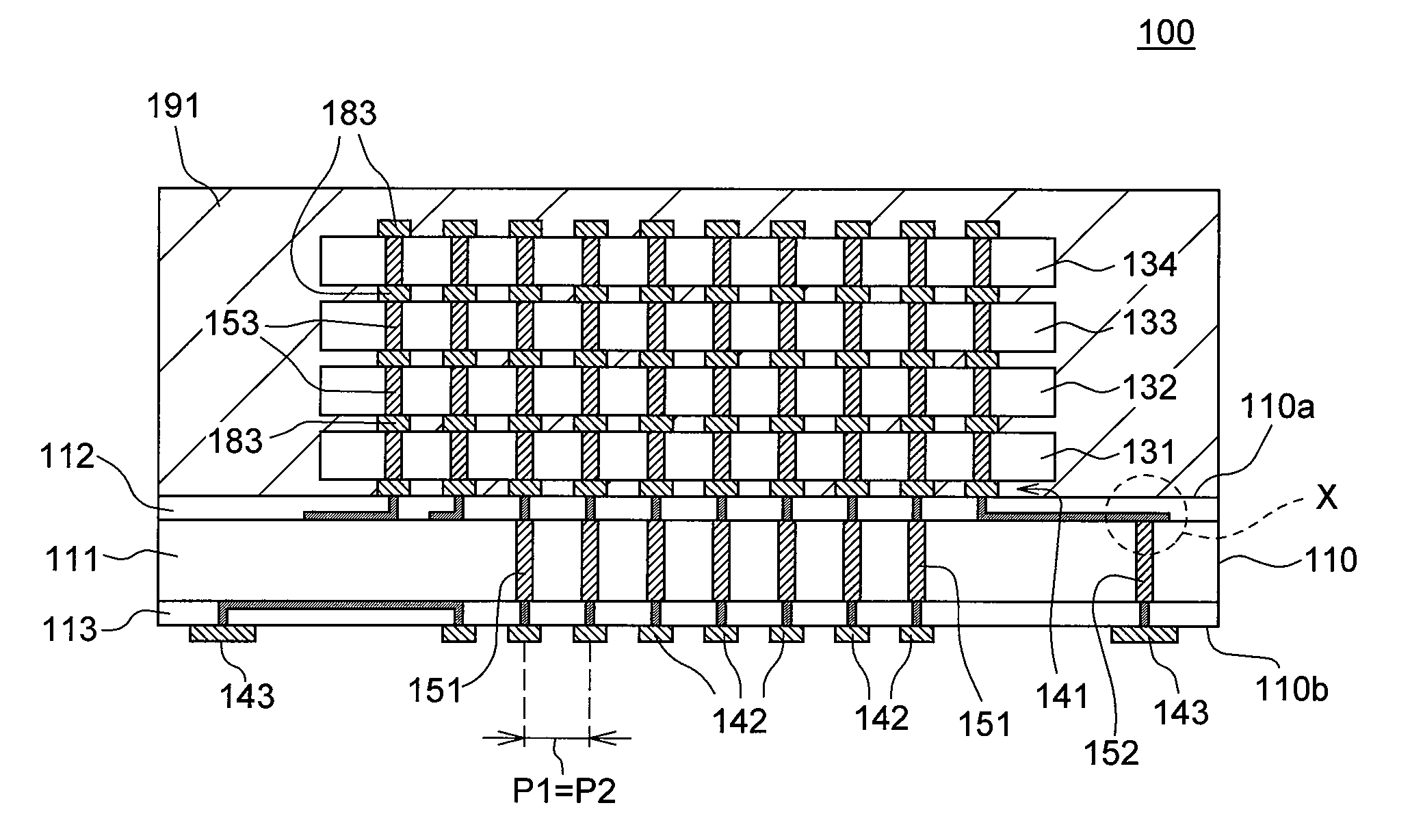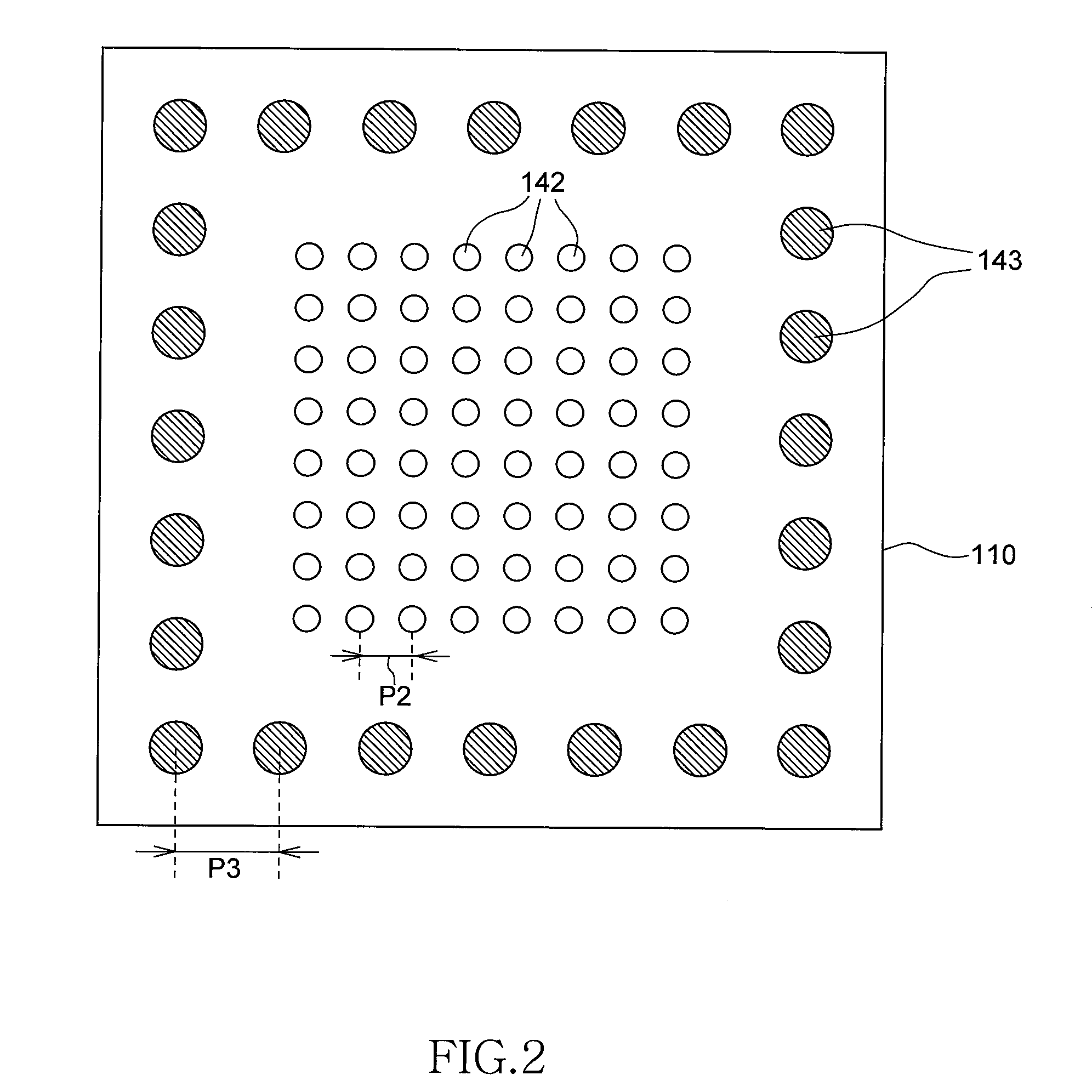Semiconductor memory device and manufacturing method thereof
a memory device and semiconductor technology, applied in semiconductor devices, semiconductor/solid-state device details, instruments, etc., can solve the problems of physical limitation of memory cells, affecting the operation speed of the device, and reducing yield
- Summary
- Abstract
- Description
- Claims
- Application Information
AI Technical Summary
Benefits of technology
Problems solved by technology
Method used
Image
Examples
first embodiment
[0037]FIG. 1 is a sectional view of a semiconductor memory device 100 according to the present invention.
[0038]As shown in FIG. 1, the semiconductor memory device 100 according to the present invention has an interposer chip 110 and core chips (four core chips, in this example) 131 to 134. The core chips 131 to 134 are mounted one above another, on a core-mounting surface 110a (first surface) of the interposer chip 110. The core chips 131 to 134 mounted on the core-mounting surface 110a are molded with an encapsulating resin layer 191.
[0039]On the core-mounting surface 110a of the interposer chip 110 there are formed first internal electrodes 141. On a core-mounting surface 110b (second surface) of the interposer chip 110, there are formed second internal electrodes 142 and third internal electrodes 143. As shown in FIG. 2, which is a plan view of the interposer chip 110 as viewed from the mounting surface 110b, the second internal electrodes 142 are arranged on a central part of th...
second embodiment
[0069]FIG. 16 is a sectional view showing a semiconductor memory device 300 according to the present invention.
[0070]The semiconductor memory device 300 according to this embodiment differs from the semiconductor memory device 100 described above, in two respects. First, the interpose chip 110 has no component equivalent to the re-wiring layer 112. Second, all re-wiring is provided on the re-wiring layer 113. Because of these different features, the first internal electrodes 141 and the third internal electrodes 143 are aligned as viewed in the vertical direction, by using the re-wiring layer 113. Hence, in the present embodiment, the pitch of the first through electrodes 151 and the pitch of the second through electrodes 152 are substantially equal to the pitch of the first internal electrodes 141. Although not shown in FIG. 16, the re-wiring layer 113 connects the second internal electrodes 142 to the third internal electrodes 143, as in the first embodiment.
[0071]All re-wiring is...
third embodiment
[0072]FIG. 17 is a sectional view showing a semiconductor memory device 400 that is the present invention.
[0073]The semiconductor memory device 400 according to the third embodiment differs in one respect from the semiconductor memory device 300 according to the second embodiment. That is, the first through electrodes 151 and the second internal electrodes 142 are not connected in the same plane. Rather, the second internal electrodes 142 are guided by the re-wiring layer 113 and are thereby adjusted in position. In the third embodiment, the first internal electrodes 141 and the second internal electrodes 142 do not need to be aligned as viewed in the vertical direction. Thus, the interface chip 120 connected to the second internal electrodes 142 can be a general-purpose ASIC or the like, not a special ASIC that has electrodes arranged in specific positions. Furthermore, the re-wiring layer 113 can serve not only to adjust the second internal electrodes 142 in position, but also to ...
PUM
 Login to View More
Login to View More Abstract
Description
Claims
Application Information
 Login to View More
Login to View More - R&D
- Intellectual Property
- Life Sciences
- Materials
- Tech Scout
- Unparalleled Data Quality
- Higher Quality Content
- 60% Fewer Hallucinations
Browse by: Latest US Patents, China's latest patents, Technical Efficacy Thesaurus, Application Domain, Technology Topic, Popular Technical Reports.
© 2025 PatSnap. All rights reserved.Legal|Privacy policy|Modern Slavery Act Transparency Statement|Sitemap|About US| Contact US: help@patsnap.com



